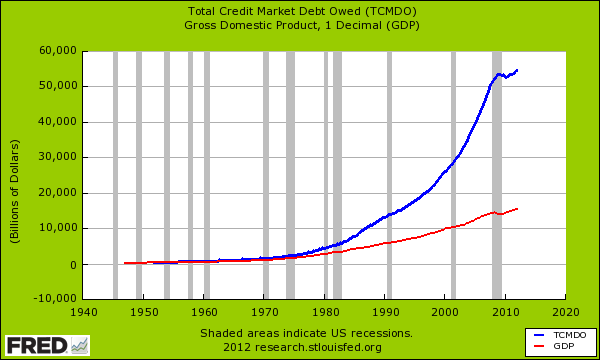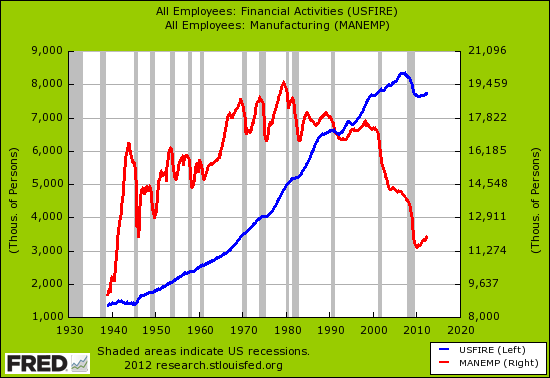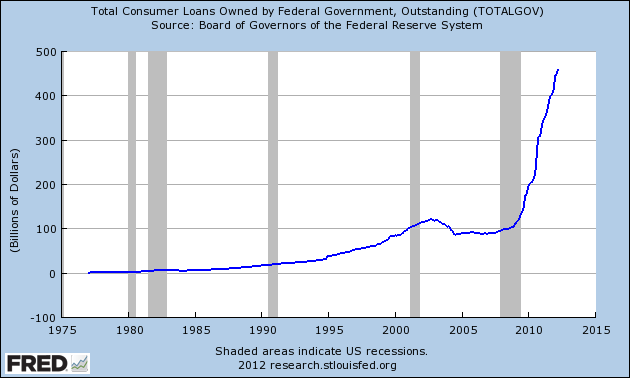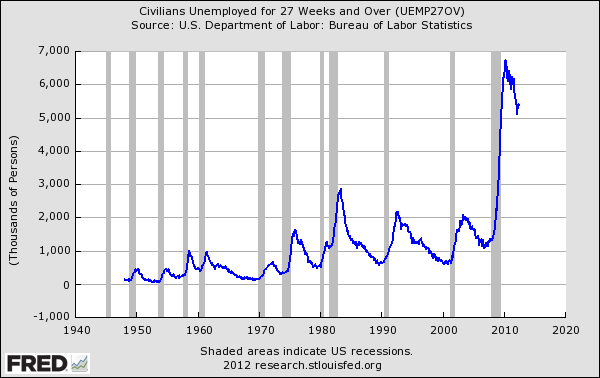The four horsemen of the sluggish economy – Total credit market debt above $55 trillion, few jobs for many unemployed, the student debt bubble, and long-term compression of wages.
- 2 Comment
The US economy is facing tremendous financial hurdles in the years to come. The current market is being held together by a flood of debt that is masking underlying issues. Total credit market debt is many times larger than our annual GDP. Student loan debt continues to expand unabated even though the return-on-investment for many college degrees is not worth it. We also have an interesting dynamic where we still do produce manufactured goods but require fewer and fewer workers to conduct these jobs. These challenges will not go away when the last ballot is cast this November. We also have big challenges of taking care of an older generation with a much less affluent and deeply in debt younger generation.
Total credit market debt
The total credit market in the US is over $55 trillion while GDP is roughly $15 trillion. This ratio was not always the case. It is interesting that once the US went off the gold standard in the 1970s did we enter a phase where deficit spending seemed to become the norm. This ballooned in the 1980s and we have yet to look back. Of course this can only continue so long as GDP growth continues to expand at a healthy pace. US GDP growth has slowed dramatically and actually contracted severely during the recession.
Global markets around the world are facing peak debt situations. The solution thus far has been to extend more debt to cover up current existing debt payments. The reality is that central banks would like to inflate the debt away since this would be the gentlest path forward yet this will bring pain to the working and middle class. Ask the unemployed around the world how gentle this path is.
US employment
Contrary to the notion that the US does not produce anything, we do produce and make a good amount of items that we export around the world. The US exported $1.5 trillion in goods in 2011 compared to $1.89 trillion for China. The big difference is that we imported $2.2 trillion while China imported $1.6 trillion. A trade deficit and surplus. Yet the US has expanded with jobs in the finance sector while contracting heavily in manufacturing:
As noted before, we are producing a good amount of items to export but with advanced machinery the amount of raw labor demanded has decreased sufficiently. While this is good for the bottom line this has displaced many working class Americans in cities like Detroit, Cleveland, Columbus, and other towns that were once manufacturing hubs. Because of this transformation, many Americans need to go back to school to retool.
Student loans
The fastest growing segment of debt in our economy is via student loans. We are nearing or at $1 trillion in student debt in the US. This wouldn’t be a problem if college degrees were yielding a solid return on investment in the market but they are not. Many students that do not go to the right school or follow the right career path find themselves in deep levels of debt and no ability to service this debt. Many move back home with parents. The government now tracks the Fed component of government loans and the chart is startling:
Keep in mind there is also a massive private loan industry and combined, student debt is now at or near $1 trillion. You also have a big segment of the student debt market being eaten up by subpar for-profit institutions that essentially give out pieces of paper that have little value in the marketplace. The next bubble that will pop is in higher education. The public is waking up to the fact that not all degrees and schools are created the same.
Long-term unemployed
Long-term unemployment is a big problem in the US. The below chart shows that we have hit a bottleneck. Also keep in mind many have shifted to part-time employment or lower paying fields and this has made the below chart look better:
These challenges show that the trend of a big boom after a deep recession is unlikely to come around this time. After all, the recession was technically over in the summer of 2009. Does it feel like things have gotten that much better since then? Not really but even in the 2000s most of the success was just one giant debt illusions as Americans spent money they didn’t have on things they couldn’t afford. The bill is now coming due and unlike the banks, the American people don’t have an unlimited credit card to the Federal Reserve.
If you enjoyed this post click here to subscribe to a complete feed and stay up to date with today’s challenging market!2 Comments on this post
Trackbacks
-
Richard Evans said:
Good job! Very clear and understandable to most everyone except the Keynsians who think that debt is OK as long as we can print money. Keep up the good work.
July 8th, 2012 at 7:20 am -
stephen said:
Time and time again I look at the middle and lower income class wages and find them declining or stagnating. Many are taking the second job part time to make up for lost purchasing power. That is why the jobs are not out there when a large percentage of the workers are holding the job that should go to someone unemployed. Meanwhile a simple search of 10K forms Corporation by Corporation finds the CEO and the CFO, COO and Boards all raking it in. These are the true killers of the economy and they all need to be taken to the woodshed.
July 8th, 2012 at 7:49 pm




 If you enjoyed this post click here to subscribe to a complete feed and stay up to date with today’s challenging market!
If you enjoyed this post click here to subscribe to a complete feed and stay up to date with today’s challenging market!